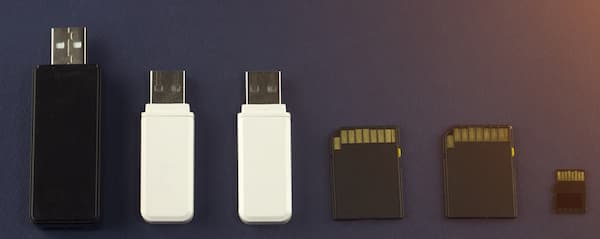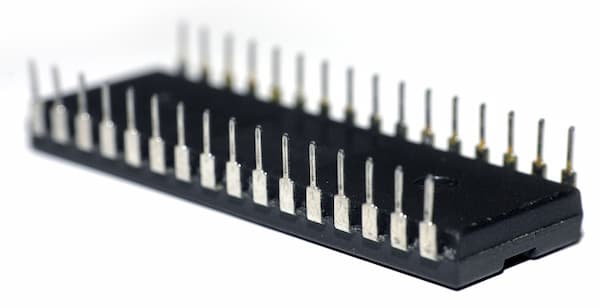
23 October, 2023
A Comprehensive Technical Guide To Flash Memory in USB Drives
Flash memory is the cornerstone technology enabling the functionality of USB drives, a data storage medium used across a variety of applications. This non-volatile form of storage has redefined portability and data transfer, rendering older technologies like CDs and floppy disks obsolete. Here we will explore what flash memory is, its architectural specifics as related to promotional USB drives, and how it operates at a technical level.
The Essentials of Flash Memory
Flash memory architecture is composed of an array of cells, each of which is made of a specialised kind of transistor known as a "floating-gate" transistor. Unlike standard transistors, the floating-gate transistor in flash memory has a unique feature: an additional insulated gate, termed the "floating gate," situated between the control gate and the transistor channel. This floating gate is enveloped by oxide layers that serve as insulators.
These floating-gate transistors are organised in a structured grid layout comprising rows and columns. Each intersection in this grid corresponds to an individual memory cell, which is essentially one floating-gate transistor. Regarding NAND flash memory, commonly used in USB drives, these cells are typically arranged in a series to form a "page," and multiple pages together make up a "block."
One of the key attributes of this architecture is its non-volatile nature. In simple terms, the data stored in the memory cells remains intact even when the power supply is removed. This is achieved by the unique ability of the floating gate to hold an electrical charge. The insulating oxide layers around the floating gate trap electrons, allowing the transistor to maintain its state (either a "1" or "0") without the need for continuous power. This starkly contrasts to volatile memory technologies like RAM, where the stored data is lost when the power is cut off.
The architectural design, specifically the non-volatility of flash memory, makes it perfect for USB drives. These drives can be plugged into or removed from a power source without the risk of data loss, offering unparalleled convenience and reliability. Furthermore, the sturdy design of the floating-gate transistors adds a layer of physical durability, which is often necessary given USB drive's portable and sometimes rugged usage conditions.
The grid layout is not just for organisational neatness but also for easy scalability. As memory technology advances, more cells can be added to the grid without requiring a complete architectural overhaul, which is beneficial for creating USB drives with ever-increasing storage capacities.
By understanding the basic architecture of flash memory, we can appreciate the technological ingenuity that allows for such compact, reliable, and scalable data storage solutions like USB drives. The architecture effectively synergises the non-volatile nature of individual cells with an organised, scalable grid layout, delivering a robust storage medium capable of meeting a wide range of data storage needs.
Operational Mechanisms

The operations of reading, writing, and erasing data on a flash memory involve manipulating charges within the floating-gate transistors. Here's how it works:
Reading: Voltage Measurement for Data Retrieval
Reading data from a flash memory cell involves applying a specific voltage across the transistor and measuring the resultant current flow. This operation determines whether the cell is storing a binary "0" or a "1."
When a voltage is applied to the control gate, it induces an electric field that influences the electrons in the floating gate. If the floating gate is charged (indicating a stored "0"), it will effectively block the flow of current through the transistor, a state that can be readily detected. If it is not charged (indicating a "1"), the current will flow freely, completing the circuit. By measuring this current, the device can ascertain the stored data bit.
Writing: Electron Injection to Program Data
Writing, also known as programming, is the process of changing the state of a memory cell to represent new data. This is achieved by injecting electrons into the floating gate of the transistor. A higher voltage is applied to the control gate, creating an electric field strong enough to push electrons through the oxide insulating layer and into the floating gate.
Once inside, the insulating layers act as a barrier, trapping the electrons. These trapped electrons then negate the electric field for that cell, allowing it to represent a binary "0." Essentially, the state of being charged or uncharged represents the stored data, with the electrons in the floating gate serving as the actual storage medium.
Erasing: Reverting to the Default State
Erasing a memory cell is essentially the reverse of the writing process. During erasing, a voltage is applied in such a way as to facilitate the movement of electrons out of the floating gate and back into the channel. This operation is typically executed at the block level rather than individual cells, meaning an entire block of cells is erased simultaneously.
Once the electrons are removed from the floating gate, the cell returns to its default "1" state, enabling it to be written again. The erasing operation makes the cell ready for a new cycle of data writing and storage.
Understanding these operational mechanisms of reading, writing, and erasing provides insight into flash memory's efficiency, reliability, and versatility. Each operation has been engineered to be as quick and fail-safe as possible, contributing to the widespread adoption of flash memory in various applications, including USB drives.
Types of Flash Memory in USB Drives

While there are different types of flash memory like NOR and NAND, USB drives primarily use NAND flash memory for its speed and high capacity.
Architecture: NAND flash uses a serial access architecture for page and block-level operations. This makes it faster for write and erase operations compared to NOR flash.
Cell Structures: In terms of cell structures, NAND flash can further be categorized into SLC (Single-Level Cell), MLC (Multi-Level Cell), and TLC (Triple-Level Cell), with each having a trade-off between speed, durability, and storage density.
Wear Leveling: NAND flash in USB drives often employs wear levelling algorithms to ensure that all memory cells have equal write and erase cycles, extending the device's lifespan.
USB Drive Specifics

When considering the technical aspects of a USB drive, it's essential to delve into some critical components that play a significant role in the overall functionality and performance of the device. These components include the Controller, File Systems, and Speed and Performance standards.
Controller: The Brain Behind Data Management
The controller chip in a USB drive is akin to the brain of the operation, yet it is often overlooked when discussing flash memory. This vital component manages the complex data storage and retrieval orchestration on the NAND flash memory. It is responsible for translating high-level data operations, such as reading and writing commands from a computer, into low-level electrical operations that manipulate the memory cells.
When a read or write command is issued, the controller determines which blocks or sectors are involved, executes error-checking protocols, and translates these operations into voltage changes that can be understood by the flash memory. By managing the interaction between the computer's file system and the actual physical storage, the controller ensures that data is stored efficiently and can be reliably retrieved.
File Systems: The Rulebook for Data Storage
Most USB drives use FAT32 or exFAT file systems primarily because they offer broad compatibility across different operating systems like Windows, macOS, and Linux. The choice of a file system affects various parameters such as the maximum allowable file size, disk capacity, and how efficiently the flash memory is used.
For example, FAT32, while being universally compatible, has a maximum individual file size limit of 4GB, which can be restrictive for transferring large media files. On the other hand, exFAT removes this size constraint but may not be natively supported on older systems. Therefore, the choice of the file system should align with the intended use-case scenarios of the USB drive.
Speed and Performance: Transfer Rates and Efficiency
USB drives come with different speed ratings, which are primarily indicated by their USB standard—like USB 2.0, USB 3.0, USB 3.1, etc. These standards govern the maximum data transfer rate, ranging from 480 Mbps (USB 2.0) to 20 Gbps (USB 3.2 Gen 2x2).
However, it's essential to note that the maximum data transfer rate isn't solely dictated by the USB standard; it also depends on the speed of the underlying flash memory. Factors like the type of NAND flash (SLC, MLC, TLC), the efficiency of the controller, and even the age of the drive can impact performance.
Conclusion
Understanding the role of flash memory in USB drives provides valuable insights into the technology that most of us use but seldom think about. With advancements in flash memory technologies, USB drives continue to evolve, becoming faster, more reliable, and increasingly capacious. As the demand for portable and reliable data storage continues to grow, so too will the technologies making it all possible, with flash memory at the heart of this evolution.
The Custom USB Drives Team




